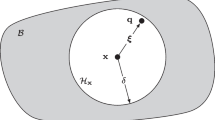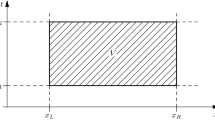Abstract
Compared to conforming P1 finite elements, nonconforming P1 finite element discretizations are thought to be less sensitive to the appearance of distorted triangulations. E.g., optimal-order discrete H1 norm best approximation error estimates for H2 functions hold for arbitrary triangulations. However, the constants in similar estimates for the error of the Galerkin projection for second-order elliptic problems show a dependence on the maximum angle of all triangles in the triangulation. We demonstrate on an example of a special family of distorted triangulations that this dependence is essential, and due to the deterioration of the consistency error. We also provide examples of sequences of triangulations such that the nonconforming P1 Galerkin projections for a Poisson problem with polynomial solution do not converge or converge at arbitrarily low speed. The results complement analogous findings for conforming P1 finite elements.
Similar content being viewed by others
References
G. Acosta, R. G. Durán: The maximum angle condition for mixed and nonconforming elements: Application to the Stokes equations. SIAM J. Numer. Anal. 37 (1999), 18–36.
I. Babuška, A. K. Aziz: On the angle condition in the finite element method. SIAM J. Numer. Anal. 13 (1976), 214–226.
D. Braess: Finite Elements. Theory, Fast Solvers and Applications in Solid Mechanics. Cambridge University Press, Cambridge, 2007.
D. Braess: An a posteriori error estimate and a comparison theorem for the nonconforming P1 element. Calcolo 46 (2009), 149–155.
S. C. Brenner: Poincaré-Friedrichs inequalities for piecewise H1 functions. SIAM J. Numer. Anal. 41 (2003), 306–324.
S. C. Brenner, L. R. Scott: The Mathematical Theory of Finite Element Methods. Texts in Applied Mathematics 15, Springer, New York, 2008.
C. Carstensen, J. Gedicke, D. Rim: Explicit error estimates for Courant, Crouzeix-Raviart and Raviart-Thomas finite element methods. J. Comput. Math. 30 (2012), 337–353.
C. Carstensen, D. Peterseim, M. Schedensack: Comparison results of finite element methods for the Poisson model problem. SIAM J. Numer. Anal. 50 (2012), 2803–2823.
M. Crouzeix, P.-A. Raviart: Conforming and nonconforming finite element methods for solving the stationary Stokes equations I. Rev. Franc. Automat. Inform. Rech. Operat. 7 (1973), 33–76.
A. Hannukainen, S. Korotov, M. Křížek: The maximum angle condition is not necessary for convergence of the finite element method. Numer. Math. 120 (2012), 79–88.
P. Jamet: Estimations d’erreur pour des éléments finis droits presque dégénérés. Rev. Franc. Automat. Inform. Rech. Operat. 10, Analyse Numer. 10 (1976), 43–60.
V. Kučera: On necessary and sufficient conditions for finite element convergence. arXiv: 1601.02942 (2016).
L. D. Marini: An inexpensive method for the evaluation of the solution of the lowest order Raviart-Thomas mixed method. SIAM J. Numer. Anal. 22 (1985), 493–496.
P. Oswald: Divergence of FEM: Babuška-Aziz triangulatiuons revisited. Appl. Math., Praha 60 (2015), 473–484.
P.-A. Raviart, J. M. Thomas: A mixed finite element method for 2nd order elliptic problems. Mathematical Aspects of Finite Element Method (I. Galligani, E. Magenes, eds.). Proc. Conf., Rome, 1975, Lect. Notes Math. 606, Springer, New York, 1977, pp. 292–315.
H. A. Schwarz: Sur une définition erroneé de l’aire d’une surface courbe, Gesammelte Mathematische Abhandlungen 2. Springer, Berlin, 1890, pp. 309–311, 369–370.
M. Vohralík: On the discrete Poincaré-Friedrichs inequalities for nonconforming approximations of the Sobolev space H1. Numer. Funct. Anal. Optimization 26 (2005), 925–952.
Author information
Authors and Affiliations
Corresponding author
Additional information
The work was triggered by a question by C. Carstensen after a talk given by the author at the 2016 European Finite Element Fair about the results from [14].
Rights and permissions
About this article
Cite this article
Oswald, P. Nonconforming P1 elements on distorted triangulations: Lower bounds for the discrete energy norm error. Appl Math 62, 433–457 (2017). https://doi.org/10.21136/AM.2017.0150-17
Received:
Published:
Issue Date:
DOI: https://doi.org/10.21136/AM.2017.0150-17
Keywords
- nonconforming P1 element
- lowest order Raviart-Thomas element
- discrete energy norm estimate
- divergence of finite element method
- maximum angle condition
- distorted triangulation




